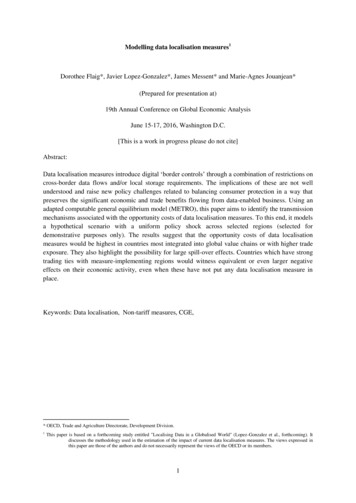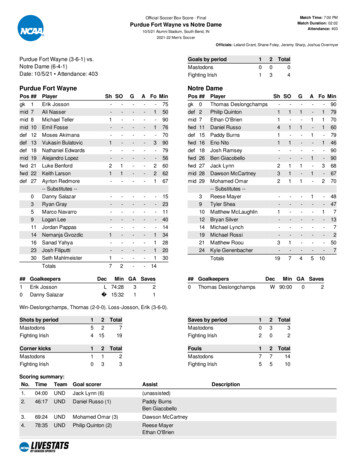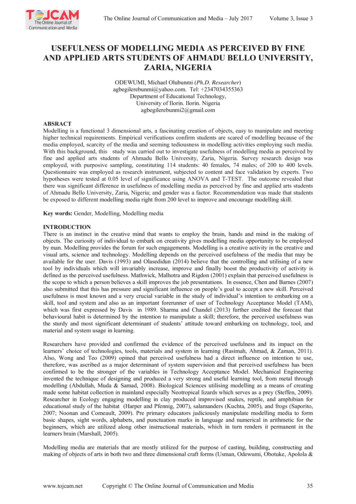
Transcription
Modelling data localisation measures1Dorothee Flaig*, Javier Lopez-Gonzalez*, James Messent* and Marie-Agnes Jouanjean*(Prepared for presentation at)19th Annual Conference on Global Economic AnalysisJune 15-17, 2016, Washington D.C.[This is a work in progress please do not cite]Abstract:Data localisation measures introduce digital ‘border controls’ through a combination of restrictions oncross-border data flows and/or local storage requirements. The implications of these are not wellunderstood and raise new policy challenges related to balancing consumer protection in a way thatpreserves the significant economic and trade benefits flowing from data-enabled business. Using anadapted computable general equilibrium model (METRO), this paper aims to identify the transmissionmechanisms associated with the opportunity costs of data localisation measures. To this end, it modelsa hypothetical scenario with a uniform policy shock across selected regions (selected fordemonstrative purposes only). The results suggest that the opportunity costs of data localisationmeasures would be highest in countries most integrated into global value chains or with higher tradeexposure. They also highlight the possibility for large spill-over effects. Countries which have strongtrading ties with measure-implementing regions would witness equivalent or even larger negativeeffects on their economic activity, even when these have not put any data localisation measure inplace.Keywords: Data localisation, Non-tariff measures, CGE,* OECD, Trade and Agriculture Directorate, Development Division.1This paper is based on a forthcoming study entitled "Localising Data in a Globalised World" (Lopez-Gonzalez et al., forthcoming). Itdiscusses the methodology used in the estimation of the impact of current data localisation measures. The views expressed inthis paper are those of the authors and do not necessarily represent the views of the OECD or its members.1
1IntroductionNew technologies are driving novel business models in this new era of globalisation. The Internet andinformation and communication technology (ICT) have not only reduced the cost of coordinatinginternationally fragmented modes of production but also that of sharing knowledge. This new era ofglobalisation is underpinned by the movement of data across international borders. But the ubiquitousexchange of data has raised concerns related to the privacy and security of consumers and led to theemergence of regulations seeking to provide greater protection to their privacy.Current data localisation measures introduce digital ‘border controls’ through a combination ofrestrictions on cross-border data flows and/or local storage requirements. The implications of theseare not well understood and raise new policy challenges related to balancing consumer protection in away that preserves the significant economic and trade benefits flowing from data-enabled business.The role of economic analysis in this debate is to provide information to weigh the existing trade-offs.In this context, the aim of this paper is to identify the transmission channels for the opportunity costsrelated to data localisation measures and not to quantify the effect of actual policies in place.The quantification of the impact of these measures is challenging. There is no clear understanding ofhow firms use data, how much data flows between countries or how data regulations might affectthem. It is therefore difficult for policy analysis to assess how restrictive data regulations are likely tobe. In this context, estimations have to rely, at least partly, on estimates and analogies. The dearth ofstatistics and detailed time-series information, added to the importance of inter-linkage effects arisingfrom the pervasive use of data across the economy, favours the use of computable general equilibrium(CGE) models over ex-post econometric approaches to assess the potential effect of data localisationregulations.A static multi-country CGE model (METRO) is used wherein a 'data' sector is split from the GTAPdatabase by applying weights informed from the TiVA database. Data localisation measures aresubsumed into two categories: measures which restrict the transfer of data across borders, andmeasures which impose restrictions on the location of data. The former is modelled as a non-tariffbarrier which creates a wedge between the domestic and the foreign price. The latter is depicted as amodified local content requirement (see Stone et al., 2015) combined with a technology shift, wherethe forced localisation causes an increase in the cost of storage which has to be satisfied by thedomestic sector.The transmission mechanisms associated with data localisation measures are evaluated using ahypothetical scenario which models a uniform policy shock across selected regions (which areselected to demonstrate the channels of transmission). The modelling exercise distinguishes betweencross-border transfer restrictions and local storage requirements.The hypothetical exercise shows that cross-border data transfer measures would increase the costs ofexports and therefore result in a decrease in export flows from the implementing country. The impact,although spread across all sectors, is especially strong in manufacturing given its high engagement ininternational trade. Production decreases in most sectors, driven by three mutually reinforcing effects:first, a direct effect from falling export demand; second a decrease in domestic demand arising fromdecreasing income; and third, growing production costs which further dampen demand.Data storage requirements would increase data service demand leading to a sizeable increase inproduction. However, most other sectors in the economy would experience increasing productioncosts lowering their competitiveness. The positive production effect in the data management sectorwould be outweighed by the negative competitiveness effects in other sectors resulting in a negativeaggregate effect on the economy.The size of the opportunity costs of both types of measures seems to depend on exporting patterns andthe degree of integration of the economy into global value chains, making the respective regions more2
or less sensitive to changes in production prices. But maybe the most important result from thismodelling exercise is that data localisation measures do not only impact the implementing region.They also affect trade partners at a scale that, according to our assumptions, can even be larger thanthe effect on the implementing region in particular for important importing neighbours.The next section provides some context related to data localisation regulations, the objectives of thesepolicies and the range of economic effects they could generate. Section 3 reviews the nature andincidence of identified measures. Section 4 provides the methodological basis for the analysis. Section5 discusses simulation results and section 6 concludes with a discussion on the implications of thefindings.2State of play: cross-border data flowsToday, the world is globalised and digitalised. Firms can effectively segment tasks or processes ofproduction and have them performed almost anywhere in the world drawing on expertise in multiplelocations. The pervasiveness of online access and ICT technologies has been credited as the drivingforce of this new era of globalisation (Baldwin, 2012). Trade and production are now heavilydependent on moving and using digital information (data) across international borders. Thisdevelopment has fundamentally changed how, what and with whom companies trade and producegoods and services.At the same time, governments and citizens have increasingly become concerned with some of thenegative side effects of so much information being collected and used, often without the knowledge ofthose individuals generating the data. Concerns related to privacy and security, amongst others, haveled to growing calls for deeper and more widespread regulations of the Internet and its underlyingdata flows. However, given the complexity of the issue, governments face the ongoing challenge ofensuring adequate privacy and security for data flows while also ensuring that users can enjoy thebenefits of a free and open Internet.2.1The role of cross-border data flows in business operationsThe digitalisation and the movement of data necessary for digital solutions to function can create tradeopportunities and deliver benefits for a large share of the business population. Modern businessmodels rely on data being collected, stored, processed and transferred within companies as well as toand from customers and business partners often located abroad.2The benefits of using cross-border data for business can arise through various channels:i.As an enabler and facilitator of new international production methods3;ii.As an engine for greater operational and production efficiency (i.e. through access to new,more sophisticated or more competitively priced digitalised service inputs4); andiii.As a conduit for new opportunities for reaching new customers or integrating into newsegments of global production.2.Detailed description of how companies in different fields rely on data, see National Board of Trade(2014) and Castro and McQuinn (2015).3Efficient supply-chain management requires the smooth flow not just of goods, services and capital, butalso of ideas and managerial know-how. Cross-border data flows are also key to managing actualproduction processes such as, for example, controlling robotics. They also play an important role inthe post-sales phase.4.Including services embedded in goods.3
These gains could be particularly welcome for SMEs and firms in developing countries which facebigger internationalisation constraints than larger firms in developed countries.5Data-use is also not limited to technology or ICT firms. Firms in all economic sectors use electronicpayment systems for international transactions, Internet-based advertising and retailing to reach globalcustomers, and cloud computing in their day-to-day operations. Production of goods and servicesinclude moving information in every step of the process. Data is used both as input into productionand delivery of goods and services as well as output when, for example, embodied in digital productsor services (van der Marel, 2015). Increasing customer demands for traceability in agricultural valuechains and business needs to better identify points of fault along these also rely on the free flow ofprocess related data across international borders.Finally, it is not just companies that receive benefits from the possibilities that digitalisation brings.Digitalisation is also increasingly empowering consumers by giving them access to global informationand products from all over the world. They benefit from better preference matching, lower prices,more variety, and greater convenience (USITC, 2013).2.2The emergence of barriers to cross-border data flows and data localisation requirementsData flow regulation is not new, it dates back to the time when international computer networks beganto be widely used (Kuner, 2015). Since their initial adoption in 1980, the OECD Privacy Guidelineshave included provisions covering "Free flow and Legitimate Restrictions" that identify key principlesfor addressing the governance of privacy and trans-border data flows. Nevertheless, the number ofdata localisation measures has increased rapidly in recent years (see Section 3). These new measurespredominantly restrict the transfer of personal data or require their localisation in servers in thedomestic economy.When examining data localisation measures it is important to look at the context of where and whythey are implemented. While data localisation measures can impede trade and give advantages tonational companies this should not automatically be equated to protectionism. Restrictions onmovement of data reflect countries’ core values, preferences and cultural and political contexts. Indiscussing the pros and cons of data localisation, the underlying policy goal should be born in mind.At the same time, at least from a trade policy perspective, one should assess if there is a less tradedisruptive way to ensure that the same policy goal is reached.6 The OECD Privacy Guidelinesrecommend that: “Any restrictions to transborder data flows of personal data should be proportionateto the risks presented, taking into account the sensitivity of the data, and the purpose and context ofthe processing” (OECD, 2013a; para. 18).The most common objective of cross-border data transfer measures is to protect the privacy of datasubjects.7 Closely related, and often based on similar arguments, are concerns relating to security.Here data localisation, through local storage requirements, is aimed at addressing concerns about5Access to free or competitively priced online business service inputs can help develop SME ordeveloping country firm competitiveness and therefore face the high costs of engaging in exportmarkets. For example, cloud computing can enable SMEs or firms in developing countries to accessIT services with little upfront investment and therefore quickly scale up their IT use in response tochanges in demand.6.USITC (2013) exemplifies how prudential concerns can be handled through a risk-based approach in onejurisdiction and through a location-based approach in another.7Kuner (2011) argues that governments have introduced data flow regulation relating to privacy in order totackle concerns relating to i) prevention of circumvention of national data protection laws, ii)safeguarding against data processing risks in other countries, iii) difficulties in asserting dataprotection abroad, and iv) enhancing consumer/individuals trust and confidence.4
foreign surveillance by keeping data out of reach. However, the localisation of data can also be soughtfor reasons related to legal jurisdiction, such as tackling tax evasion, identifying fraudulent activityand regulating, or auditing, firms operating within the domestic territory (for example financial,insurance or accounting services). But governments might also have several, sometimes contradictory,reasons for introducing data-related regulation. For example, while officially introducing data storagedemands on the grounds of privacy protection for citizens, it may also be aimed at facilitating accessto citizens’ data by the security services of the government in question (Hon et al., 2015).2.3The expected effects of barriers to cross-border data flows and data localisationrequirementsThe economic impacts of data localisation on business activity can be framed in the context of wellknown concepts in the economic literature. For example, data localisation measures closely resemblestandards which can be mandatory or, in some instances, voluntary and can either facilitate or impedetrade (Swann, 2010). They can be trade facilitating when they bridge informational asymmetries,enhance predictability or reduce compliance burdens, but trade impeding when they do not coincidewith commercial realities, the compliance costs are onerous or when they favour local over foreignentities. Multiple standards can also be a source of uncertainty for business; if they are conflictingacross different countries they can add to compliance costs due to a need to design systems to meetdifferent standards in different markets.Data localisation measures closely resemble standards. Standards can be mandatory or, in someinstances, voluntary and can either facilitate or impede trade (Swann, 2010). They can be tradefacilitating when they bridge informational asymmetries, enhance predictability or reduce complianceburdens, but trade impeding when compliance costs become onerous or when these favour local overforeign entities. Multiple standards can also be a source of uncertainty for business; if they areconflicting across different countries they can add to compliance costs due to the need to designsystems to meet different standards in different markets.Data-related measures can have a positive economic effect through enhanced trust in digital products.Mandating companies to keep data locally could increase the willingness of companies andindividuals to use Internet solutions thereby increasing the demand for such services. This can arisefrom, for example, the reduction of informational asymmetries between consumers and companiesand the consequent reduction in adverse selection (Akerlof, 1970).8 Stakeholder input and literaturesuggests that localisation demands may indeed lead to increased on-line demand and usage of on-linesolutions (European Parliament, 2012). However, it is unclear how much of this is a result of sounddata regulation and private solutions as opposed to source-switching towards domestic services as aresult of the restrictions themselves. Moreover, while consumers might trust local providers more thanforeign ones, it may not always be that case that local providers have the most security/privacyfeatures, from a technical standpoint.On the other hand, localisation requirements can divert trade and production to national suppliers ofintermediate goods and services (Stone et al., 2015). These legal requirements can run counter to theGVC trend which has seen an increasing use of foreign service inputs (OECD, 2013b) by imposingdomestic sourcing where foreign sourcing may be more efficient (National Board of Trade, 2015, andBauer et al., 2015). Evidence also suggests that the localisation demands leading to the construction ofnew servers in the country, which often use mainly foreign inputs, comes with modest job creation8.Akerlof noted that asymmetric information can have market efficiency reducing effects (market failures).If the quality of a product is not readily observable by the consumer, then the seller can defraud the buyerby selling a lower quality good at the high quality price. In repetitive transactions, consumers will realisethat they are being scammed and either reduce the price they are willing to offer for the product or reducetheir demand for the product. If government intervention can help signal consumers that their privacy isbeing appropriately handled by the firms then the demand for high privacy content services can rise.5
and reduces transfers of technology and knowhow (Chander and Lê, 2014). Such protectionist goalscould therefore end up being counterproductive in the longer term.Localisation measures create direct costs of compliance. Resources from the legal or IT departmentswill need to be used to understand the new measures, meet the conditions attached to transfer data, tostrip personal information out of current data and store this new information. More indirect costs arisefrom companies using potentially less efficient and pricier local suppliers, rather than accessing globaldigital services or international outsourcing solutions.Firms might have to relocate and replicate certain functions such as after-sales services or datamanagement facilities, to particular countries in response to the measures. This will disrupt centralisedbusiness solutions which could lead to inefficiencies arising from the loss of access to scaleopportunities. It could also decrease the use and efficiency of data trends like big data (Kuner, 2011;USITC, 2014; Kaplan and Rowshankish, 2015; Hon et al, 2015; Chander and Lê, 2014; NationalBoard of Trade, 2014).These measures are likely to impact firm decisions related to production, investment, and trade.Smaller countries or those where the current economic activity or population cannot justify the costsof setting up new servers or implementing processes to deal with the emerging measures would bemost vulnerable. This could deprive developing countries of access to productivity enhancing digitalsolutions. The measures could place disproportionate burden on SMEs compared to large firms.Smaller firms are likely to have a lower capacity than larger firms to face the increased compliancecosts that sustaining economic activity or entering markets with data localisation requirements entails.Likewise, SMEs may have a harder time shifting to local suppliers and facing the higher costsassociated with this, leading to a relatively greater impact on their competitiveness.3The nature and incidence of data localisation measuresData-related measures have received growing attention from policy-makers, academics and theinternational press (see Forbes, 2015). However our understanding of the nature and evolution of theexisting measures is limited. To fill in the informational gaps, Lopez-Gonzalez et al. (forthcoming)compiles a database of existing measures applied by governments. It provides greater clarity about thenature of the measures and therefore their possible economic impact.3.1Nature and incidenceThe measures identified in Lopez-Gonzalez et al. (forthcoming) are pieces of legislation, regulation, orpolicies that have been implemented by governments and are currently in-force. They fall under twocategories, measures that restrict the flow of data and measures that require local storage (with a thirdcategory being a combination of the two).Cross border transfer measures tend to allow cross-border data transfers to take place providedcertain requirements are met (i.e. obtaining explicit consent of the data subject, the recognition ofadequate government data protection settings in the receiving country, or individual contracts betweennational companies that receive data transfers setting out the latter's data protection obligations).9 In9.The full list of conditions include: adequate or equivalent data protections standards; model contractclauses between the recipient and the data controlling authority in the sending country; binding corporaterules; explicit consent of the data subject; consent of a government official; the transfer is necessary tocomplete a contract for the data subject; the transfer is necessary for medical treatment of the datasubject; the transfer serves in the public interest; where the information is already in the public domain;the transfer is required by statute; falls within international judicial cooperation; as part of internationalintelligence cooperation regarding crime, terrorism or drug trafficking; where the recipient organisationis controlled by the organisation that manages the data; where the sender takes reasonable steps to ensure6
general, associated costs are likely to be shouldered by the private sector that may need to adaptbusiness processes to adhere. Failure to meet the protection standards or a decline of consent wouldprohibit any data transfer.Local storage requirements demand that a company store data on servers located within theimplementing country/region. To meet these measures, firms must incur costs associated with thisstorage. There are many different business models for storage, ranging from a firm installing andmaintaining data servers themselves, to outsourcing the service to international or local firms.While the most stringent forms of regulation are likely to be those that combine local storage andprohibit cross-border transfers, the evidence in Lopez-Gonzalez et al. (forthcoming) suggests that theseare sector specific and therefore their aggregate impact is likely to be small. Nevertheless, forparticular sectors, measures of this nature imply not only the installation and maintenance ofadditional data servers, but also the use of local data processing services.The number of data-related measures has been growing over time and there are signs suggesting thatmeasures are becoming more restrictive in nature (Figure 1). In particular, the combination of crossborder data transfer prohibition and local storage conditions is a relatively new phenomenon.Most of the cross-border measures identified target personal data across the entire economy (Figure 2a); while the data localisation measures focus on how data is to be handled in a range of specificsectors of activity, such as financial, telecommunications, health, business, or the public sector(Figure 2 b).10 This suggests that the data transfer measures potentially have economy-wide effects,resulting in all sectors of the economy having to adapt their data solutions. By contrast, storagemeasures are more targeted and therefore are likely to have smaller aggregate impacts.Figure 1. Evolution of stock of data measuresBy class of measuresFlow RestrictionProhibitionLocal Storage Requirement1009080706050403020100Source: adapted from Lopez-Gonzalez, et al. (forthcoming)that adequate data protection exists; or where the recipient self-certifies to adequate data protectionstandards10.Though all of these types data will also be (or at least include) personal data.7
Figure 2. Stock of data measures identified, by type of affected data(a) data transfer measuresHealthTelecommunicatio3ns3Public2All data1Financial6Personal60(b) data localisation measuresHealth2Public2All e: Lopez-Gonzalez, et al. (forthcoming)3.2Data localisation as an NTMIn principle, the approach to quantify the impact of data localisation policies on business activity andtrade is likely to be similar to assessments of the impact of other non-tariff measures (NTMs) orregulations on trade. Regulatory measures affecting trade in goods and services, such as for exampleSPS standards, bear strong similarities with those affecting the movement of data. The task ofquantifying these, which is already a complex one in the case of goods and services (Fugazza andMaur, 2008), is compounded by the lack of information on i) data flows and on how firms use data fortheir business activity; and ii) the restrictiveness of the new data localisation measures.11There are different approaches to incorporate and analyse non-tariff measures using CGE models(Fugazza and Maur, 2008). Border effects of NTMs are generally measured in terms of ad-valoremequivalents (AVEs) which are derived from estimates of the differences between world and domesticprices. One approach to modelling changes in NTM-policies is to represent these as border taxesexpressed as AVEs that rise or fall as a result of policy reform. One challenge in this approach,however, lies in the difficulty of calculating these AVEs. Another is that, unlike tariffs, NTMsgenerally do not generate any revenue for the government (the rent is kept by the domestic company),so that the revenue impacts of NTM-reform in CGE analysis has to be interpreted carefully(Andriamananjara et al., 2003).11.Moreover, many data localisation measures have been introduced over recent years, so that there is littletime series information available to empirically assess their impact through econometric methods.8
Another modelling approach rests on the assumption that NTMs, in the form of divergent technicalstandards, lead to lower economic efficiency. Policy reform through harmonization of standards or theconclusion of mutual recognition agreements would then be captured in the CGE context asimprovements in economic efficiency that make it possible to reduce domestic producer prices by theamount of the NTM’s ad valorem equivalent (Hertel et al., 2001). This approach has similarly beenused to assess the benefits from trade facilitation reforms (OECD, 2003; Francois et al., 2005), and tocapture some of the impacts of services trade reform (Christen et al., 2012).There have been few prior attempts at using CGE-modelling to evaluate the impacts of dataregulations. ECIPE (2013) used the GTAP model to assess the impacts of the EU's prospectiveGeneral Data Privacy Regulation on GDP, services sector output and trade. The authors model theeffect of introducing new data regulations as friction-generating impediments to international tradethat cause efficiency losses. They calibrate their model with data from an impact assessmentundertaken on behalf of the UK government (United Kingdom Ministry of Justice, 2012) and relativelabour costs inside and outside the EU. They find that the negative impact on the EU’s GDP couldreach -0.8% to -1.3%, and that EU services exports to the United States could drop by -6.7% due toloss of competitiveness.In another study, Bauer et al. (2014) assess the impact of data privacy and security laws, includingdata localisation requirements, in seven jurisdictions, namely Brazil, China, the European Union,India, Indonesia, South Korea and Vietnam. They construct an index of administrative barriers byapplying weights for each regulatory measure and type of restriction based on available impactassessments, so as to take into account the relative importance of each policy measure in the economy(van der Marel et al., 2014). This index is then used to econometrically estimate the loss in total factorproductivity, which in turn is used to derive the magnitude of the efficiency-shock in the GTAP-CGEmodel. Bauer et al. (2014) also make adjustments in GTAP to the return on investments in order tocapture costly market limitations that discourage capital spending. In terms of simulation results, theauthors report that the impact of proposed or enacted data legislation on GDP is substantial in allseven countries, to the extent that the data regulations can undo the productivity increases from majortrade agreements.These first attempts at measuring the impact of data regulation on economic activity are laudable andare based on the assumption that data regulation reduces productivity. While this is not anunreasonable assumption, the way that the data localisation measures were integrated into the CGEmodel may be contentious. The previous studies enacted economy wide changes in both productivityand savings, which might be seen as an upper bound to the impact of the measures. In so doing, theydid not capture the mechanisms that will be outlined in subsequent sections.4Model and databaseThe modelling strategy differs in
database by applying weights informed from the TiVA database. Data localisation measures are subsumed into two categories: measures which restrict the transfer of data across borders, and measures which impose restrictions on the location of data. . ensuring adequate privacy and security for data flows while also ensuring that users can enjoy the










